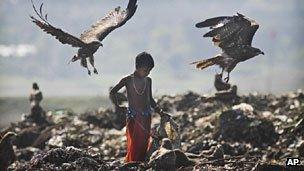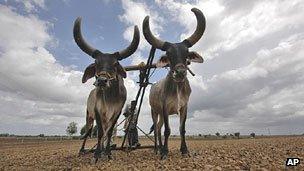India food law: The hungry republic
- Published
- comments

India has the largest number of malnourished children in the world
Will the proposed law to provide cheap food to more than half of India's people eliminate hunger, the most shameful scourge of an aspiring superpower?
The jury is still out on how the $19bn (£12bn) scheme will work, as is the case with similar big-ticket welfare schemes launched by what many believe is an endemically weak and corrupt state.
But there is little doubt that India needs to fight malnutrition on a war footing, external, and the food security scheme may well be its last chance to redeem itself.
Many believe that it does not behove a country which never tires of gloating about its red hot economic growth to have millions of malnourished and starving people.
The facts on the ground are startling. India has the largest number of malnourished children in the world, a rate worse than the average in Africa.
Nearly half of India's children under three are malnourished. More than half of the tribes' children are underweight and stunted.
India fares worst in terms of low birth weight and underweight children, and under-five infant mortality compared to Brazil, Russia and all South Asian neighbours.
'Alarming situation'
India also has the highest number of Vitamin A deficient , externalchildren in the world: nearly 6% of the children suffer from eye problems related to the deficiency. Of the 37m people in the world who are blind, about 15m are from India. More than 320,000 children suffer from avoidable blindness.
There are shocking disparities between states when it comes to hunger and malnutrition. All states have a "serious to extremely alarming situation of hunger", says the latest India Human Development report.
Among the most well-off states, Gujarat - the Economist magazine called it India's Guangdong, external - fares the worst in terms of overall hunger and malnutrition.
Other economically prosperous states like Tamil Nadu and Karnataka have serious hunger problems. "Economic prosperity alone cannot reduce hunger," says the report.

The results of the previous programmes designed to combat food insecurity have been mixed
The results of the government's largest nutritional programme, external, the 36-year-old Integrated Child Development Scheme, have been mixed. It provides nutrition to children below the age of five years - children get snacks and hot cooked meals at lunch.
There is still no consensus as to whether the programme has worked. Coverage of pregnant and lactating mothers, for example, is still low.
There are two more programmes for feeding adolescent girls, but neither provides for universal distribution of supplementary nutrition for them.
Then there are India's notoriously fickle public distribution system , externalshops aimed at providing food security to people. Over 500m people are supposed to benefit through a gigantic distribution network of half a million fair-price shops supplying cheap food grains.
Here too, the results are mixed and contested, external. In many states, it has failed to make cheap food grains available to the poor. Theft of supplies, fraudulent beneficiaries and hoarding by the shop-owners is not uncommon.
Cart before horse?
So will the latest food security scheme aimed at providing subsidised food grains to 75% of the rural population and half of the urban households work?
There are many economists who wonder how India will cough up the funds to finance the scheme which will see the country's food subsidy bill climb to $19bn from $13bn. The government insists money will not be a problem.
There are also questions about how beneficiaries will be identified and targeted in a transparent manner in a country where there are different official estimates of the poorest of the poor - from 37% to 77% of the people, depending on whom you believe.
India's state-run cold storage system is shambolic, so where is the guarantee that some 65m tonnes of food grains procured from farmers for distribution for the scheme - up from 55m tonnes presently - will not rot before reaching the beneficiary? How can the food grains be distributed through the leaky public distribution system shops without reforming them?
So is India again putting the cart before the horse? Without reforming its laws and public institutions, welfare schemes with the best intentions run the risk of floundering.
For the scheme to work, the government will need to target beneficiaries properly and revamp the distribution system. The public distribution system, for example, could be made accountable by issuing smart cards to beneficiaries to eliminate bogus cards and fraudulent withdrawal.
If the food security scheme does not work, economists believe, India is doomed to remain a hungry republic. It is already one of the fast-growing economies with the hungriest people in the world. And it can get worse.
- Published19 December 2011
